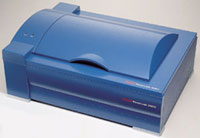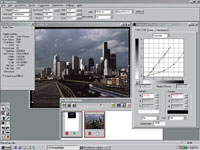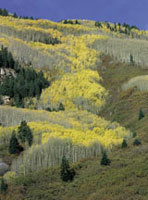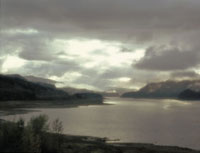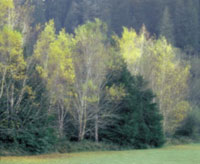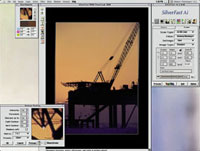The Umax PowerLook 3000
Since I've been answering reader's questions for the Digital Help column, one frequent source of interest is a scanner which can work with all sizes of film. Until now I've had to answer that question negatively and advise getting a separate 35mm film scanner and a flat-bed with good resolution which is capable of scanning film. This report is about a professional quality Umax scanner they describe as, "The Flat-bed Drum Scanner," implying it has the capability to do it all, with high professional quality. Now that's a tall order unless you're talking about equipment well into the five figure price category, or consider film scanners with limited capabilities that are just under $10K in price. But the Umax PowerLook 3000 offers film scanning and print scanning up to 8.5x11" with an optical resolution up to 3048dpi for film up to 3.4" wide, and 1220x3048dpi for larger sizes, and at a list retail price of $7695. |
||||||
Unusual in performance and price, the Umax PowerLook 3000 is also unique in its construction and functions. At first glance it seems like just a rather large flat-bed scanner. It can be described as such, but rather than having a fixed bed and a moving scan bar inside, the Umax has a moving, steel framed, optical glass bed, a fixed dual lens sensor array and illumination sources. The dual, distinct optical setups are the secret to the high-resolution, one providing a "picture" of the whole width of the scan bed, the other just one third, and both focused on a 10,500 element CCD array. That takes care of more than adequate resolution at 3048dpi for even film as small as a 35mm frame (higher than the most popular 35mm scanner at 2700dpi), and very high for all 120 size films, and even a slightly cropped 4x5. Larger film sizes like 5x7 and 8x10 at the 1220dpi optical maximum across, is also much more than adequate. |
||||||
This great range of scanning
resolution and image size/formats supports professional standards, it
also scans at 14-bit depth per RGB channel, 42 bits in all, and can be
output in 24-bit or 42-bit mode. And finally, the other key dimension
of scan quality, dynamic range, is a healthy 3.6. The scanner is also
supported with a SCSI 2 interface, and two different scanner driver software
packages, MagicScan 4.3, and PowerColor 4.0. |
||||||
At the present time multiple
image holders are only available from Umax in 35mm size. The 120 and 4x5
size film holders supplied are single units. However, from working successfully
with 35mm mounted in Wess Plastic glassless mounts with the scanner, I
would assume if they have glassless mounts for 120 sizes they would function
equally well for batch scanning. |
||||||
Working with just one image
at a time, the PowerLook 3000 is not as fast as some 35mm scanners, but
using its ability to batch scan makes up for that and then some. Fortunately
I have a number of scanner film holders and was able to put at least three
or four 120 size images on the scan bed at a time. For anyone who is using
the scanner for archiving, combining this batch ability and selecting
output in 42-bit mode, is both advantageous in securing a file with all
of the scan data collected by the Umax in it in an archived file, which
can then be color corrected for different applications later. |
||||||
In all other dimension applied
to all color media, the Umax PowerLook 3000 provided distinctly superior
image quality to any flat-bed scanner I've worked with, and a close
match or better than the professional larger format film scanners. In
other words the visual qualities of the images scanned in sharpness, and
detail is everything and sometimes more than what you would expect based
on the visual appearance of the film image. The range of tones captured
by the scanner provides fine separation of values, and color saturation
and the delineation of tints and hues is a precise representation of the
original image. |
||||||
Umax supplies two software
drivers with the PowerLook 3000, the MagicScan 4.3 which is supplied also
with less sophisticated scanners in their line, and is quite capable and
easy to use, but is not as sophisticated as this excellent piece of hardware
demands. That is probably why the PowerColor 4.0 package was added, which
is a much more complex, and powerful scanner control application. Both
are available for the Macintosh and Windows. PowerColor 4.0, unfortunately,
is designed more for pre-press and CMYK output than for RGB photo purposes.
This does not mean that it does not function well for RGB output, but
that it is difficult to use it well, because the operation paradigm is
quite alien to what a user of Photoshop would find familiar. |
||||||
Technical Specifications |
||||||
LaserSoft SilverFast
Ai For The Umax PowerLook 3000 |
||||||
|
||||||
| For more information about SilverFast contact LaserSoft Imaging at (941) 383-7496 or visit their web site at: www.silverfast.com. The software package for the Umax PowerLook 3000 scanner is $1119, or $1284 for IT-8 calibration. SilverFast is available for a wide range of scanners from very high-end professional models through inexpensive consumer versions and priced accordingly. As well as an independent of any scanner means to process high-bit image files in the HDR version, Photo CD access and correction Photoshop plug-in. | ||||||
